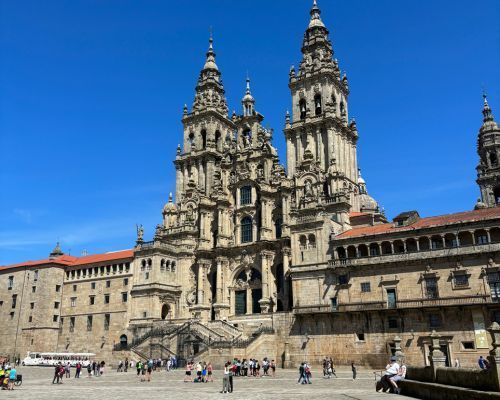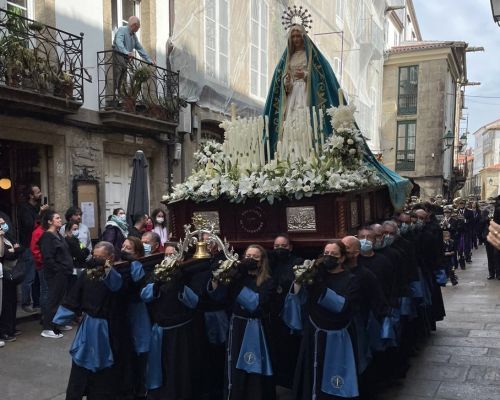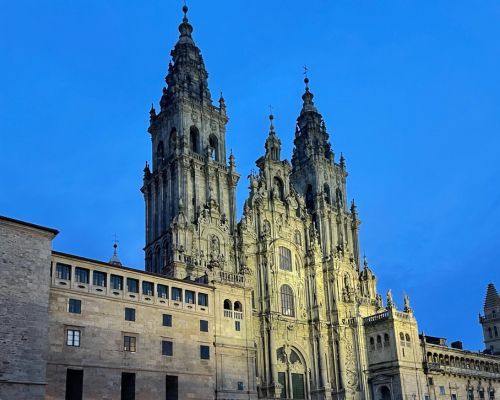Get in touch
(+353) 21 4851711
info@travelnet.ie
7 Nights - Final Stage Sarría to Santiago - Easter 2025
Duration:
7 Nights
€840 single supplement | €730pp sharing
13th April 2025
The schedule for the final stage of what’s known as ‘The French Camino’. It’s called that because it starts just inside the French Border with Spain. This final stage is popular with people on the Camino for the first time, the walking is relatively easy, it’s very well serviced with accommodation and cafe stops along the way, and arriving into Santiago is a great experience.
DAY 1
Arrive at Santiago airport and private transfer to Sarria, two hours Eastwards.
DAY 2
Your first day's walk sees you leave Sarria through the town's old quarter and into the countryside. You'll have a coffee break after 5km or so, and lunch later on at Ferreiros before arriving at Portomarin.
DAY 3
Portomarin to Palas de Rei. 24km.
You continue your walk today which is a combination of forrest paths and tracks, and stretches of quiet country roads, and like yesterday, there will be a morning break and a stop for lunch along the way before the final 7km walk to Palas de Rei.
DAY 4
Palas de Rei to Arzua. 28km.
Today is our longest day’s walk, and is divided into two stages. You’ll arrive to Melide after 14km, and there are plenty well spaced out coffee stops along the way. You’ll have lunch there before continuing on to Arzua through more forest tracks and paths, plus a roadway stage as you approach the town. There’s a coffee stop at Boente after 7km.
DAY 5
Arzúa to Pedrouzo, 18km.
A mixture of forest tracks, paths and road brings you to a lunch break at Emplame before the final 3km to Pedrouzo. I’ll arrange a taxi transfer to bring you from there to where you are staying.
At Pension Entre Camino.
DAY 6
Final day's walk into Santiago, 19km.
You eventually pass through Monte de Gozo or Mound of Joy, where the early Pilgrims caught the first glimpse of the Cathedral in the square.
DAY 7
Free day to explore the city, visit the Cathedral, and go to the Pilgrim’s Office to collect your certificate!
DAY 8
Transfer to the airport for flight home.
SARRIA
The town of Sarria first appeared in records as far back as the 6th century, and became a significant place during the reign of Alfonso IX who died there in the 13th. As you climb the steps towards the old and original part of the town, you pass the church of Santa Maria, the Galician Romanesque style Parish Church of El Salvador and the nearby building said to be site of the Hospital de San Antonio. You'll also see the remains of Sarria Castle, destroyed during the feudal wars of the 15th century. A little further on, you'll pass by the impressive Monastery La Magdalena on the right before you go downhill and turn left over the Roman bridge, Ponte Aspera and pass the ancient village of Santi Michaelis, of which there are now no visible remains.
Our route takes us past the Church of Santiago de Barbadelo with its Galician Romanesque architecture and interesting carvings and motifs. The church used to be attached to a monastery thought to exist from the 9th century, but no trace now remains. Early records say that it could have been a 'Monasterium' where both monks and nuns resided and whose chief function was to provide hospitality to passing pilgrims. On then to Ferreiros where blacksmiths provided horse shoeing and walking boot repair services.
TO PORTOMARIN: (23km)
After passing numerous small villages, including Ferreiros for your lunch stop, the steep downhill road walk brings you to Portomarin. You cross the bridge over the river Mino and the reservoir constructed in the 1950's which flooded the original town. The importance of Portomarin historically is due to the three military religious orders based there in the Middle Ages. The Knights of Santiago and the Knights Templar on the Left Bank, while the impressive fortified church of St. Nicolau, now San Xoan in the town square, was the headquarters of The Order of The Knights of St. John of Jerusalem, the original Order of Malta. Look closely and you'll see how each stone block was numbered before it was dismantled from the original town in the valley below and reconstructed in its present position.
TO PALAS DE REI: (24km)
Leaving Portomarin, you cross the Belesar reservoir by another route and take the short steep climb along the forrest path of Monte de San Antonio, which suggests that there may have been an Antonian Monastery Hospital in the surrounding area, although no remains have been found. On then to Gonzar (coffee break) with its parish church dedicated to St. Mary and further on, the Hospital da Cruz, again of which, nothing remains. Next is Ligonde, "formerly an important halt on the road to Compostela, its Church of Santiago, though almost entirely neoclassical, conserves the portal of its Romanesque predecessor". You’ll pass the high point of Ventas de Naron, the scene of a fierce battle between Christian and Muslim troops in 820. The Order of St. James were the ‘Guardia Civil’ of the day, protecting Pilgrims from the 12th and subsequent centuries.
On reaching Palas de Rei, don't be alarmed by early pilgrim reports of the town and surrounding areas where "Innkeeper's servants along the road to Santiago, who taking pleasure in seduction for illicit gain, are inspired by the Devil himself to get into pilgrim's beds at night, are fully reprehensible. Harlots who go out to meet pilgrims in wild parts between Portomarin and Palas de Rei for this purpose, should not only be excommunicated, but also stripped of everything and exposed to public ridicule, after having their noses cut off". There are various assumptions that the town 'Palacium Regis' had ancient royal connections, but there is no documentary evidence of this. It was however, an important point along the Roman road between Lugo and Astorga.
TO MELIDE: (14km plus further 14km to Arzúa)
The 14km stretch from Palas de Rei to Melide is probably one of the nicest sections on this final stage from Sarria to Santiago. Melide is the ‘Geographical Centre of Galicia and has a deep
Jacobean tradition’ and is the meeting point with the Camino Primativo, the oldest recorded route originating in the North East from Oviedo. You pass the small 12th century Romanesque Parish church of San Julian do Camino, and Porto de Bois, or 'The Pass of the Oxen' the scene of a battle between Henry of Trastamara who defeated the Duke of Lemos, a supporter of the legitimate King Pedro 1 while his army was retreating back towards Santiago. As you near the village of Coto, watch for the marker indicating that you are passing from the province of Lugo to A Coruna. Once you leave the tar road you'll walk along the restored ancient medieval way.
Eventually you cross the 'Ponte Velha', a medieval bridge spanning the river Furelos after which the historically designated village is named. The Parish Church of San Juan is directly ahead and is an important stop to collect another 'Sello' for your Pilgrim's Passport. The village is now a Unesco Heritage Site. You now have 52.3km left to travel. If you're breaking the long 28km day from Palas de Rei to Arzúa into two, it's well worth spending time in Melide. Along with Arzúa, Melide was the point where Pilgrims walking the Northern or Camino Primativo ways joined with the French Route. Sometimes, they would leave the French route at Leon to visit Oviedo in Asturias and the relics at the Cathedral of San Salvador. Melide has an impressive town hall and local museum, the Parish Church with the usual gruesome statues, and the Church of Santa Maria. The town is noted for its seafood, many cafes and central shaded seating area to watch the passing Pilgrims continuing onwards to Arzúa.
TO ARZÚA
A further 7km or so Westwards from Melide, you pass through Boente, divided between Upper and Lower. There's time for another coffee break and a visit to the Parish Church of St. James on the Main Street, another must to add to your collection of passport Sellos. A little further on is Castaneda, the site of the furnaces where lime was prepared for the construction of the Cathedral in Santiago. Pilgrims, when passing through Triacastela, the town before Sarria to the East, would pick a stone from the local lime quarries and carry it to the furnaces at Castaneda. Nearing Arzúa, you cross the River Iso at Ribadiso. The Hospital de San Anton de Ponte was a lifeline to travellers from the 15th. Century and is now a very popular Hostel stop. Arzúa is a fine lively town with its modern Parish Church of Santiago, lots of coffee haunts and the usual focal point square.
ON TO RUA, PEDROUZO, AND FINALLY TO SANTIAGO: (19km plus 18km)
You take the cobbled stone route at the rear of Hotel Teodora leaving the town along the Rua do Carmen and onto the forest path through Salceda, Empalme, Sta. Irene before reaching your stop for the evening which may be at Rua or the short distance further to the town of Pedrouzo, which is always busy and lively with Pilgrims from Sarria, or all points from St. Jean Pied de Port and between, now looking forward to their final day’s walk into Santiago. There is now just 19km to the Plaza del Obradoiro, the Cathedral Square in Santiago. You pass by the Parish Church of Sabugueira in Lavacolla dedicated to San Pelayo and which was a significant spot on the final journey for early Pilgrims. " There is a river called Lauamentala, because in a leafy spot along its course, a few miles from Santiago, French Pilgrims on their way to Santiago take off their clothes and, “for the love of the Apostle, wash not only their private parts ('mentulas'), but the dirt from their entire bodies"
[Aymeric Picaud; 'Liber peregrinations' Pilgrim's Guide written in Latin in 12th. Century.]
Next place of note is Monte del Gozo, or 'Mound of Joy' where it's advisable to rest up for a light lunch and view where early Pilgrims caught their first view of 'The Holy City of Compostela' before walking the final 5km to the City and where once stood the enormous monument remembering the visit of Pope John Paul II. Before heading off down the hill, get your final Sello at the little Capilla de San Marcos which is usually open during the busy Pilgrim seasons. Entering Santiago is like walking towards the centre of any major bustling city suburbs, but as you near your goal, keep an eye out for the pillars remembering previous famous visitors, the Parish Church of San Lazaro, once part of a 12th. Century Leprosarium on your left, and finally crossing the busy junction and through the 'Puerta del Camino', the main entrance for Pilgrim walkers.
Your first close up view of the Cathedral will be its North facade in the Plaza de La Azabacheria, before you decend the steps (go on, spare a small coin for the musician!) to the magnificent Plaza del Obradoiro. If you walk to the centre of the square in order to fully appreciate the front facade of the Cathedral, on your left is the Hostal de Los Reyes Catolicos, founded in 1492 as a Pilgrim's hospital and still functioning as such up to the 1950's, now known as the city's Parador Hotel. On your right stands the Colegio de San Jeronimo, founded in the 15th century and now the seat of the Rectorate of Santiago University. And finally, behind you is the Palacio de Rajoy, the Town Hall and seat of the Xunta de Galicia, the Regional Government of Galicia.
So, whether from Sarria, St. Jean Pied de Port or all points in between, congratulations and well done! Collect your Compostela and explore this wonderful city.
PREPARATION
A reasonable level of fitness and walking experience will help you enjoy this journey all the more, so put together a walking programme at home before your chosen date. No need to walk far or fast, just get out once a week or so and walk continuously for a couple of hours and you'll be well prepared. Hopefully the weather will be good for whichever date you choose, and if we feel it may be warm on any particular day, we simply leave a little earlier, but generally, 8.30 is our starting time each morning. Footwear is obviously very important, and many people use good strong walking runners while others prefer light hiking boots for increased support. We will be walking along paths and tracks, quiet country roads and through some forrest areas. There are also a few rough stoney stretches on some stages of the Camino where care is needed, especially going downhill.
Plenty pairs of tightly fitting socks are important to minimise the risk of developing blisters, and they shouldn't become a problem if you bring sensible walking footwear that you know and trust. It goes without saying that you should bring good quality sunscreen, especially if you're comfortable in shorts and light sleeveless tops, and a good sun hat is important for extra protection. Many people like to bring walking poles for extra support and comfort, especially on uneven ground, just make sure that they fold up small for your luggage bag. Even in Summertime the evenings can be chilly, so a light fleece is an option and a pair of sandels to change into is a good idea. And, a light rain jacket or poncho which hopefully you won't need, is essential as the the weather can be very changeable at times.
And finally, we want to emphasise that this is an adventure and a holiday, not an endurance test to be worried about. We pass through some wonderful countryside, towns and villages large and small, and we will meet others from all over the world doing exactly as we are. So, coming on the Camino with a good frame of mind is probably the most important element in your preparation
- Private airport transfers
- Accommodation
- Bed & Breakfast basis
- Luggage transfers each day
- Flights



Need Help?
Opening Hours
Monday to Friday : 09:00 to 17:00
Saturday : 10:00 - 14:00
Opening time are local to Ireland
Follow Us
Useful Links
Newsletter Sign Up
Sign up for our newsletter to stay up to date on the latest news, offers and promotions!
Secure Payment Methods



New paragraph
Your Holiday Guarantee
Licensed by the Irish Aviation Authority, TA0720.
Holidays 100% protected
Travelnet.ie is a trading name of
J Barter International Ltd
92 Patrick Street, Cork, Ireland Registration No 100308
Licensed by Commission Aviation Regulation
TA 0720 - Holidays 100% protected
Foreign travel advice: Department of Foreign Affairs, Ireland have up-to-date advice on staying safe and healthy abroad. Click Here> to get the latest advice.






